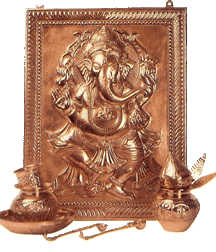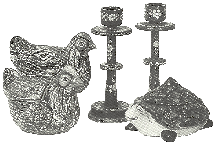| Crafts of Maharashtra |
| Metal work in copper, brass and other alloys was being conducted in several
places in Maharashtra for centuries. Old records reveal that there was a large
manufacture of idols in all the metals at Nasik & Pune. Good brass utensils
were also made at Kelshi and at Begmandli in the Ratnagiri Collectorate. Bombay
Copper Bazaar was also equally known as recorded by Birdwood. He had observed
that: "The most active industry in the town of Bombay is the manufacture of
brass and copper pots and other untensils in universal use among natives of
India. The Cooper Bazaar opposite Mombadevi Tank is the busiest and the
noisiest, and one, of the most delightful streets in all the native town. Mr.
Terry states (Maclean's Guide to Bombay) that, there are 1,069 coppersmiths,
and 1,536 blacksmiths in Bombay." |
| That Copper Bazaar of Bombay does not
exist now. In today's stainless steel age', hand made metal crafts cannot
survive. But in Nasik, even today there are hundreds of craftsmen who have
their workshops and shops in a particular lane known as Tambat Ali. Some of the
craftsmen can still execute untensils and vessels with traditional designs. |
 |
|
| Objects such as ghangal, abhishek patra, ghagar (water pot), pan-patra, laman-diwa (hanging oil lamp), samai etc are today collected by art loving
people as decorative objects and not as objects of utility. Several highly
artistic craft objects such as kalamdan, pan-dan, nutcracker (adkitta), foot
scrubbers, toilet box, pali (spoon) for rituals and various types of oil lamps,
which we see in Raja Dinkar Kelkar Museum, Pune and in other collections may
have been executed in Nasik and Pune. Murbad is also known for copper and brass
work. Along with other utility vessels Murbad produces miniature kitchen
vessels and utensils as toy objects for girls to play with and get education
for becoming future housewives. |
| Diemaking craft of Parola in Jalgaon district is one of the surviving crafts of
Maharashtra. In Parola there lives a family name Jade who have been practicing
the craft of diemaking for the last four generations. |
|
| Some diemaker families have also settled in Virar and Sopara near Bombay. They
make dies, fully hand carved, without the use of a pantograph. They have also
developed their own carving instrument out of hard steel, which are numbering
about two hundred. |
| Dies are carved on thick bronze plates and the bronze is obtained from South
India in the form of old traditional utensils especially the thick serving
plates. |
| Images of Gods and Goddesses are carved into dies, negative and positive and
the print is taken on relatively thick silver or copper foil. The icon is known
as take and used for worshiping. It is sold in the shops situated near temples. |
| Maharashtra can boast of producing a variety of textiles. The Marathas extended
their patronage to industrial and other textile activities after they succeeded
the Mughals. They adopted some forms of Islamic fashions. But their special
regard for traditional Hindu garments encouraged the development of textile
centres. |
| Following is the list of centres along with their products: |
| Paithan- asavali or paithani saris pitambara, kinkhab. |
| Yeola- paithani, jamdani, pitambara |
Aurangabad- himroo and mashru
Balapur & Sangamner- chandrakala saris
Daulatabad- muslin
Ter- muslin, cotton
Shahugad- shahugadi
Nasik & Pune- brocade
Nagpur- Silk bordered dhotis
Amravati & Bhir- pasodi saris
Solapur Kolhapur & Tuljapur- khanas, cotton
Ahmednagar- all types of cotton
Dharwad- khanas, dharwadi saris
Pandharpur- ghongodi, pasodi, pitambara
Akola- pasodi, shela |
| Out of all these products, paithani, himroo, mashru and brocade are the special
types of textiles and they are rich in both, the material and craftsmanship.
However, in brocade, Banaras excels, hence Pune and Nasik cannot compete with
it. |
| Mashru is a mixed variety of striped cotton and silk
weave. It was generally used by the ladies as an undergarment. The basic warp
is of silk and the weft is of various colored |
 |
|
| cottons. The term mashru is
derived from share, meaning "legal". The weaving of pure silk fabrics at
prayers was prohibited among the Muslims and hence this pattern was introduced.
Paithan and Aurangabad were the famous centres of mashru production. Himroo is
a similar variety of mixed silk and cotton but with a texture that is almost as
fine as muslin. It is used as veils, head-dresses, bridal robes and saris. It
is costlier than mashru. Paithani is the most costly high quality silken gold
embroidered textile which has an interesting history. Paithani is called as
Mahavsatra. |
| Against this broad historical backdrop we can now see which crafts of
Maharashtra have overcome the dark periods and once again re-established their
vital existence to arrest the attention of the art lovers and connoisseurs of
the present times. |
| Some crafts have inevitably disappeared because of the changing environment and
the life style of contemporary Indian society. Some crafts were totally
neglected and forgotten. |
|
| But some traditional craftsmen who used to produce their craftsmen who used to
produce their crafts with high degrees of excellence patiently suffered the
isolation when their craft lost patronage. However they preserved their
technique in the lean period and waited for things to change. Things did change
after Independence and new opportunities were offered to them. Once again they
rose to the occasion and produced their art objects with the same dexterity and
aesthetic vision which was once considered as a hall mark in the world of
specialized crafts. This is a story of the revival of Paithani- the rich silken
gold embroidered sari of Paithan. |
| Another example is of a traditional goldsmith applying his technique to produce
the imaginative silver jewellery. Today the silver jewellery of Hupri (near
Kolhapur) is considered the best in the country. |
| Revival of lacquer work and other crafts of Sawantwadi is another interesting
story. The rich traditional craft of Chitaris (painters) of Sawantwadi had
almost vanished a few years ago. Today this world famous crafts has been
revived and the new generation of craftsmen are engaged in creating their craft
objects with the same traditional skill. |
Maharashtra can take pride in these three revived crafts which we shall now
study in depth.
|
| Page 1 |